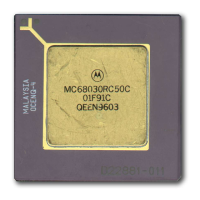Data Organization and Addressing Capabilities
2-18 MC68030 USER’S MANUAL MOTOROLA
2.4.14 Program Counter Memory Indirect Postindexed Mode
This mode is similar to the memory indirect postindexed mode described in 2.4.9 Memory
Indirect Postindexed Mode, but the PC is used as the base register. Both the operand and
operand address are in memory. The processor calculates an intermediate indirect memory
address by adding a base displacement (bd) to the PC contents. The processor accesses a
long word at that address and adds the scaled contents of the index register and the optional
outer displacement (od) to yield the effective address. The value of the PC used in the
calculation is the address of the first extension word. The reference is a program space
reference and is only allowed for reads (refer to 4.2 Address Space Types).
In the syntax for this mode, brackets enclose the values used to calculate the intermediate
memory address. All four user-specified values are optional. However, the user must supply
the assembler notation ZPC (zero value is taken for the PC) to indicate that the PC is not
used. This allows the user to access the program space without using the PC in calculating
the effective address. Both the base and outer displacements may be null, word, or long
word. When a displacement is omitted or an element is suppressed, its value is taken as
zero in the effective address calculation.
31 0
31 0
31 0
31 0
31 0
31 0
EFFECTIVE ADDRESS:
NUMBER OF EXTENSION WORDS: 1,2, 3, 4, OR 5
EA = (bd + PC) + Xn.SIZE*SCALE + od
([bd, PC], Xn.SIZE*SCALE,od)
111
011
GENERATION:
ASSEMBLER SYNTAX:
MODE:
REGISTER FIELD:
PROGRAM COUNTER:
SIGN-EXTENDED VALUE
SCALE VALUE
OPERAND
+
+
31
0
BASE DISPLACEMENT:
INDEX REGISTER:
MEMORY ADDRESS
INDIRECT MEMORY ADDRESS
VALUE AT INDIRECT MEMORY
ADDRESS IN PROGRAM SPACE
POINTS TO
SIGN-EXTENDED VALUE
SIGN-EXTENDED VALUE
+
X
OUTER DISPLACEMENT:
07

